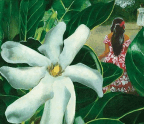Auckland
Debbie Harris Corpse Flowers and Chewing Gum
Föenander Galleries, 4–22 August
BECKY RICHARDS
Featuring an ambitious banquet of gutsy ceramic sculpture, Debbie Harris's Corpse Flowers and Chewing Gum leads viewers down a candycoated garden path. Muscular floral oddities congregate in wild beds: apexes of stretching coiled forms and voluptuous botanicals, tiny colour-pop daisies proliferating on the ground plane. Harris's first solo exhibition following the completion of her Master's degree, this mixed-media installation debuts an astonishing quantity of new work, combining the artist's established tactics with marked developments in sculptural practice.
Harris's entities are reminiscent of ring-necked Seuss palms, or Sendak's leafy forests—cartoon flora squeezed and coaxed into corporeal abundance, almost monstrous in their sheer size and physicality. A veritable pink princess of ceramics, Harris's chosen palette glistens like Barbie's wardrobe, or those gummy-glitter jelly shoes that were a childhood staple.
While her new work has largely retained its iced-cupcake sweetness, recent sculptures demonstrate a significant evolution in her approach to surface treatment. Ponytail Palm, from 2020, a gorgeous, bulging throwback to the artist's MVA graduate exhibition, wears a floating skin of soft underglaze washes in lilac and peach, held by a coat of clear glaze.

In contrast, 2023's Patchwork Quilt Flower is slick with evidence of Harris's recent dedication to expanding her glaze vocabulary; appliquéd swatches of pastel gloss wrap the form with a luminous depth—glass and pigment fusing into the clay body. A similar surface pattern appears on Too Blue To Behave (2023)—here invigorated with cobalt and sunflower yellow. There is such nostalgic delight in these glaze compositions—1990s paint-bynumbers meets Carle's Very Hungry Caterpillar.
Giraffe Flower (2023) stands as a tonal outsider, interrupting the spread of confectionery. The work's monochrome black gloss casts it as the single liquorice jellybean, a gothic triffid that underscores the abject quality lurking in Harris's magic planting. These creatures are fleshy, oozing with glimpses of viscera, their scale and squishy construction adding palpable heft. Despite their high appeal and Polly Pocket colour scheme, Harris's large sculptures rarely evoke the word ‘cute’. The same cannot be said for her army of miniflowers-600 strong and popping up everywhere—a fairy-tale ground cover that counters Harris's lick of the grotesque with a sense of pure discovery.
Several new works show an upward trend in the artist's practice—trading bulk for height, and extending limbs skyward. (2023) and illustrate this shift in technical reach—both are stacked forms, fired in






